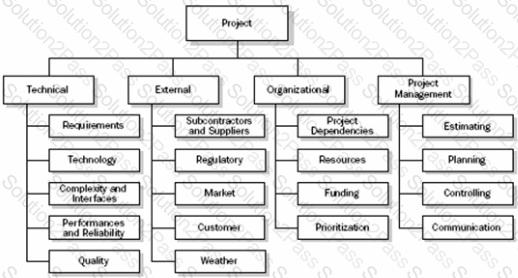CAPM PMI Certified Associate in Project Management (CAPM) Free Practice Exam Questions (2025 Updated)
Prepare effectively for your PMI CAPM Certified Associate in Project Management (CAPM) certification with our extensive collection of free, high-quality practice questions. Each question is designed to mirror the actual exam format and objectives, complete with comprehensive answers and detailed explanations. Our materials are regularly updated for 2025, ensuring you have the most current resources to build confidence and succeed on your first attempt.
One of the objectives of a quality audit is to:
Activity cost estimates are quantitative assessments of the probable costs required to:
Which baselines make up the performance measurement baseline?
The item that provides more detailed descriptions of the components in the work breakdown structure (WB5) is called a WBS:
Which Process Group contains the processes performed to complete the work defined in the project management plan to satisfy the project specifications?
The process to ensure that appropriate quality standards and operational definitions are used is:
A tool and technique used during the Define Scope process is:
What is project management?
Which type of dependency is contractually required or inherent in the nature of the work?
Projects are separated into phases or subprojects; these phases include:
Which statement is true about the project management body of knowledge?
What happens to a stakeholder's project influence over time?
At which stage of team development do members begin to work together, adjust work habits, and trust each other?
Which process requires implementation of approved changes?
The contract in which the seller is reimbursed for all allowable costs for performing the contract work and then receives a fee based upon achieving certain performance objectives is called a:
The process for performing variance analysis may vary, depending on:
The diagram below is an example of a:

Fast tracking is a schedule compression technique used to shorten the project schedule without changing project scope. Which of the following can result from fast tracking?
The risk shared between the buyer and seller is determined by the:
During project selection, which factor is most important?
Which tool or technique can a project manager use to select in advance a team member who will be crucial to the task?
Which of the following includes how requirements activities will be planned, tracked, and reported?
Which of the following is an output of Close Procurements?
Which of the following are three inputs to the risk register?
The probability and impact matrix is primarily used to:
A project manager has created an issue log to document issues communicated by project team members during weekly team meetings. This is an input of:
The correct equation for schedule variance (SV) is earned value:
While preparing the project management plan on a weekly basis, the project manager indicates the intention to provide an issues report to the staff via e-mail. In which part of the plan will this type of information be included?
The three processes of Project Cost Management are:
Which of the following is a tool or technique used in the Determine Budget process?
Which of the following is a tool or technique used in the Acquire Project Team process?
Which of the following can be used as an input for Define Scope?
The application of knowledge, skills, tools, and techniques to project activities to meet project requirements describes management of which of the following?
The initial development of a Project Scope Management plan uses which technique?
The staffing management plan is part of the:
A project lifecycle is defined as:
Which of the following is an estimating technique that uses the values of parameters from previous similar projects for estimating the same parameter or measure for a current project?
In which type of contract are the performance targets established at the onset and the final contract price determined after completion of all work based on the sellers performance?
A project management office manages a number of aspects including the:
What cost control technique is used to compare actual project performance to planned or expected performance?
Which tools or techniques will a project manager use for Develop Project Team?
The approaches, tools, and data sources that will be used to perform risk management on a project are determined by the:
Which process includes prioritizing risks for subsequent further analysis or action by assessing and combining their probability of occurrence and impact?
Project or phase closure guidelines or requirements, historical information, and the lessons learned knowledge base are examples of which input to the Close Project or Phase process?
What is the total float of the critical path?
In an organization with a projectized organizational structure, who controls the project budget?
An input of the Control Schedule process is the:
What tool and technique is used to determine whether work and deliverables meet requirements and product acceptance criteria?
Which of the following investigates the likelihood that each specific risk will occur?
Which of the following is a narrative description of products, services, or results to be delivered by a project?
Which tool and technique identifies inefficient and ineffective policies, processes, and procedures?
Which of the following risk response strategies involves allocating ownership of a positive risk to a third party?
When is a Salience Model used?
An electronics firm authorizes a new project to develop a faster, cheaper, and smaller laptop after improvements in the industry and electronics technology. With which of the following strategic considerations is this project mainly concerned?
The stakeholder register is an output of:
When is a project finished?
When would resource leveling be applied to a schedule model?
Which Knowledge Area is concerned with the processes required to ensure timely and appropriate generation, collection, distribution, storage, retrieval, and ultimate disposition of project information?
An output of the Create WBS process is:
Which of the following is an input to Direct and Manage Project Execution?
